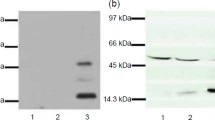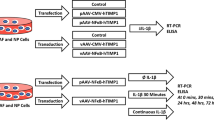Abstract
To develop new therapeutic options for the treatment of disc degeneration we tested the possibility of overexpression of active growth and differentiation factor (GDF) 5 and of transforming growth factor (TGF) β1 by adenoviral gene transfer and characterized its effect on cell proliferation and matrix synthesis of cultured rabbit and human intervertebral disc cells. Recombinant adenovirus encoding for GDF-5 or TGF-β1 was developed and transgene expression characterized by RT-PCR, western blot and ELISA. Growth and matrix synthesis of transduced cells was measured by [3H]thymidine or [35S]sulfate incorporation. Disc cells expressed the receptors BMPR1A, BMPR1B, and BMPR2, which are relevant for GDF-5 action. Adenovirus efficiently transferred the GDF-5 gene or the TGF-β1 gene to rabbit and human intervertebral disc cells. About 50 ng GDF-5 protein/106 cells per 24 h or 7 ng TGF-β1 protein/106 cells per 24 h was produced. According to western blotting, two GDF-5 forms, with molecular weights consistent with the activated GDF-5 dimer and the proform, were secreted over the 3 weeks following gene transfer. Overexpressed GDF-5 and TGF-β1 were bioactive and promoted growth of rabbit disc cells in monolayer culture. Our results suggest that ex vivo gene delivery of GDF-5 and TGF-β1 is an attractive approach for the release of mature and pre-GDF-5 in surrounding tissue. This leads us to hope that it will prove possible to improve the treatment of degenerative disc disease by means of ex vivo gene transfer of single or multiple growth factors.







Similar content being viewed by others
Abbreviations
- BMP :
-
Bone morphogenetic proteins
- CHO :
-
Chinese hamster ovary
- ELISA :
-
Enzyme-linked immunosorbent assay
- FCS :
-
Fetal calf serum
- GDF :
-
Growth and differentiation factor
- GFP :
-
Green fluorescent protein
- IVD :
-
Intervertebral discs
- MOI :
-
Multiplicity of infection
- TGF :
-
Transforming growth factor
References
Adler JH, Schoenbaum M, Silberberg R (1983) Early onset of disk degeneration and spondylosis in sand rats (Psammomys obesus). Vet Pathol 20:1
Hirsch C Schajowicz F (1953) Studies on structural changes in the lumbar annulus fibrosus. Acta Orthop Scand 22:184–231
Pearce RH, Grimmer BJ, Adams ME (1987) Degeneration and the chemical composition of the human lumbar intervertebral disc. J Orthop Res 5:198–205
Silberberg R, Aufdermaur M, Adler JH (1979) Degeneration of the intervertebral disks and spondylosis in aging sand rats. Arch Pathol Lab Med 103:231–235
Holm S (1996) Nutritional and pathophysiological aspects of the lumbar intervertebral disc. In: Wiesel SW (ed) Lumbar spine, 2nd edn. Saunders, Philadelphia, pp 285–310
Lipson SJ (1996) Biochemistry and cell biology of the intevertebral discs: aging versus degeneration. In: Wiesel SW (ed) Lumbar spine, 2nd edn. Saunders, Philadelphia, pp 310–316
Urban J (1996) Disc biochemistry in relation to function. In: Wiesel SW (ed) Lumbar spine, 2nd edn. Saunders, Philadelphia, pp 271–281
Masuda K, Shirota H, Thonar EJ (1994) Quantification of 35S-labeled proteoglycans complexed to alcian blue by rapid filtration in multiwell plates. Anal Biochem 217:167–175
Gruber HE, Fisher EC Jr, Desai B, Stasky AA, Hoelscher G, Hanley EN Jr (1997) Human intervertebral disc cells from the annulus: three-dimensional culture in agarose or alginate and responsiveness to TGF-beta1. Exp Cell Res 235:13–21
Benz K, Breit S, Lukoschek M, Mau H, Richter W. (2002) Molecular analysis of expansion, differentiation and growth factor treatment of human chondrocytes identifies differentiation markers and growth-related genes. Biochem Biophys Res Commun 293:284–292
Thompson JP, Oegema TR Jr, Bradford DS (1991) Stimulation of mature canine intervertebral disc by growth factors. Spine 16:253–260
Guerne PA, Sublet A, Lotz M (1994) Growth factor responsiveness of human articular chondrocytes: distinct profiles in primary chondrocytes, subcultured chondrocytes, and fibroblasts. J Cell Physiol 158:476–484
Nishida K, Kang JD, Suh JK, Robbins PD, Evans CH, Gilbertson LG (1998) Adenovirus-mediated gene transfer to nucleus pulposus cells. Implications for the treatment of intervertebral disc degeneration. Spine 23:2437–2442
Nishida K, Kang JD, Gilbertson LG, Moon SH, Suh JK, Vogt MT, Robbins PD, Evans CH (1999) Modulation of the biologic activity of the rabbit intervertebral disc by gene therapy: an in vivo study of adenovirus-mediated transfer of the human transforming growth factor beta 1 encoding gene. Spine 24:2419–2425
Boden SD, Andersson GBJ, Anderson DG, Damien C, Ebara S, Helm G, Lane JM, McKay B, Sandhu HS, Seeherman H (2002) Overview of bone morphonetic proteins for spine fusion. Spine 27:S1
Luyten FP (1997) Cartilage-derived morphogenetic protein-1. Int J Biochem Cell Biol 29:1241–1244
Tsumaki N, Nakase T, Miyaji T, Kakiuchi M, Kimura T, Ochi T, Yoshikawa H (2002) Bone morphogenetic protein signals are required for cartilage formation and differently regulate joint development during skeletogenesis. J Bone Miner Res 17:898–906
Hoetten GC, Matsumoto T, Kimura M, Bechtold RF, Kron R, Ohara T, Tanaka H, Satoh Y, Okazaki M, Shirai T, Pan H, Kawai S, Pohl JS, Kudo A (1996) Recombinant human growth/differentiation factor 5 stimulates mesenchyme aggregation and chondrogenesis responsible for the skeletal development of limbs. Growth Factors 13:65–74
Francis-West PH, Abdelfattah A, Chen P, Allen C, Parish J, Ladher R, Allen S, MacPherson S, Luyten FP, Archer CW (1999) Mechanisms of GDF-5 action during skeletal development. Development 126:1305–1315
Buckwalter JA (1995) Aging and degeneration of the human intervertebral disc. Spine 20:1307–1314
Oegema TR Jr (1993) Biochemistry of the intervertebral disc. Clin Sports Med 12:419–439
Sprugel KH, McPherson JM, Clowes AW, Ross R (1987) Effects of growth factors in vivo. I. Cell ingrowth into porous subcutaneous chambers. Am J Pathol 129:601–613
Wakefield LM, Winokur TS, Hollands RS, Christopherson K, Levinson AD, Sporn MB (1990) Recombinant latent transforming growth factor beta 1 has a longer plasma half-life in rats than active transforming growth factor beta 1, and a different tissue distribution. J Clin Invest 86:1976–1984
Moon SH, Gilbertson LG, Nishida K, Knaub M, Muzzonigro T, Robbins PD, Evans CH, Kang JD (2000) Human intervertebral disc cells are genetically modifiable by adenovirus-mediated gene transfer: implications for the clinical management of intervertebral disc disorders. Spine 25:2573–2579
Kroeber MW, Unglaub F, Wang H, Schmid C, Thomsen M, Nerlich A, Richter W (2002) New in vivo animal model to create intervertebral disc degeneration and to investigate the effects of therapeutic strategies to stimulate disc regeneration. Spine 27:2684–2690
Poller W, Schneider-Rasp S, Liebert U, Merklein F, Thalheimer P, Haack A, Schwaab R, Schmitt C, Brackmann HH (1996) Stabilization of transgene expression by incorporation of E3 region genes into an adenoviral factor IX vector and by transient anti-CD4 treatment of the host. Gene Ther 3:521–530
Gambaryan S, Wagner C, Smolenski A, Walter U, Poller W, Haase W, Kurtz A, Lohmann SM (1998) Endogenous or overexpressed cGMP-dependent protein kinases inhibit cAMP-dependent renin release from rat isolated perfused kidney, microdissected glomeruli, and isolated juxtaglomerular cells. Proc Natl Acad Sci USA 95:9003–9008
Vaandrager AB, Tilly BC, Smolenski A, Schneider-Rasp S, Bot AG, Edixhoven M, Scholte BJ, Jarchau T, Walter U, Lohmann SM, Poller WC, de Jonge HR (1997) cGMP stimulation of cystic fibrosis transmembrane conductance regulator Cl-channels co-expressed with cGMP-dependent protein kinase type II but not type Ibeta. J Biol Chem 272:4195–4200
Graham FL Prevec L (1991) Manipulation of adenovirus vectors. In Clifton (ed) Methods in molecular biology. Human, New York, pp109–128
Wang EA, Rosen V, D’Alessandro JS, Bauduy M, Cordes P, Harada T, Israel DI, Hewick RM, Kerns KM, LaPan P (1990) Recombinant human bone morphogenetic protein induces bone formation. Proc Natl Acad Sci USA 87:2220–2224
Benz K, Breit S, Lukoschek M, Mau H, Richter W (2002) Molecular analysis of expansion, differentiation, and growth factor treatment of human chondrocytes identifies differentiation markers and growth-related genes. Biochem Biophys Res Commun 293:284–292
Chelberg MK, Banks GM, Geiger DF, Oegema TR Jr (1995) Identification of heterogeneous cell populations in normal human intervertebral disc. J Anat 186:43–53
Buckwalter JA, Pedrini-Mille A, Pedrini V, Tudisco C (1985) Proteoglycans of human infant intervertebral disc. Electron microscopic and biochemical studies. J Bone Joint Surg Am 67:284–294
Yasuma T, Koh S, Okamura T, Yamauchi Y (1990) Histological changes in aging lumbar intervertebral discs. Their role in protrusions and prolapses. J Bone Joint Surg Am 72:220–229
Maeda S Kokubun S (2000) Changes with age in proteoglycan synthesis in cells cultured in vitro from the inner and outer rabbit annulus fibrosus. Responses to interleukin-1 and interleukin-1 receptor antagonist protein. Spine 25:166–116
Melrose J, Ghosh P, Taylor TK, Hall A, Osti OL, Vernon-Roberts B, Fraser RD (1992) A longitudinal study of the matrix changes induced in the intervertebral disc by surgical damage to the annulus fibrosus. J Orthop Res 10:665–676
Weiler C, Nerlich AG, Zipperer J, Bachmeier BE, Boos N (2002) 2002 SSE Award Competition in Basic Science: expression of major matrix metalloproteinases is associated with intervertebral disc degradation and resorption. Eur Spine J 11:308–320
Roberts AB Sporn MB (1993) Physiological actions and clinical applications of transforming growth factor-beta (TGF-beta). Growth Factors 8:1–9
Sporn MB Roberts AB (1992) Transforming growth factor-beta: recent progress and new challenges. J Cell Biol 119:1017–1021
O’Kane S Ferguson MW (1997) Transforming growth factor beta s and wound healing. Int J Biochem Cell Biol 29:63–78
Trippel SB (1995) Growth factor actions on articular cartilage. J Rheumatol Suppl 43:129–132
Galera P, Redini F, Vivien D, Bonaventure J, Penfornis H, Loyau G, Pujol JP (1992) Effect of transforming growth factor-beta 1 (TGF-beta 1) on matrix synthesis by monolayer cultures of rabbit articular chondrocytes during the dedifferentiation process. Exp Cell Res 200:379–392
Harrison ET Jr, Luyten FP, Reddi AH (1992) Transforming growth factor-beta: its effect on phenotype reexpression by dedifferentiated chondrocytes in the presence and absence of osteogenin. In Vitro Cell Dev Biol 28A: 445–448
Yaeger PC, Masi TL, de Ortiz JL, Binette F, Tubo R, McPherson JM (1997) Synergistic action of transforming growth factor-beta and insulin-like growth factor-I induces expression of type II collagen and aggrecan genes in adult human articular chondrocytes. Exp Cell Res 237:318–325
Jakob M, Demarteau O, Schafer D, Hintermann B, Dick W, Heberer M, Martin I (2001) Specific growth factors during the expansion and redifferentiation of adult human articular chondrocytes enhance chondrogenesis and cartilaginous tissue formation in vitro. J Cell Biochem 81:368–377
Yung LJ, Hall R, Pelinkovic D, Cassinelli E, Usas A, Gilbertson L, Huard J, Kang J (2001) New use of a three-dimensional pellet culture system for human intervertebral disc cells: initial characterization and potential use for tissue engineering. Spine 26:2316–2322
Acknowledgements
We thank Regina Hess and Michael Rühle for technical assistance, Jens Pohl, Biopharm GmbH, for the donation of GDF-5 cDNA, and Sven Schneider for the statistical analysis. This work was supported by a grant from the research fund of the Stiftung Orthopädische Universitätsklinik Heidelberg.
Author information
Authors and Affiliations
Corresponding author
Rights and permissions
About this article
Cite this article
Wang, H., Kroeber, M., Hanke, M. et al. Release of active and depot GDF-5 after adenovirus-mediated overexpression stimulates rabbit and human intervertebral disc cells. J Mol Med 82, 126–134 (2004). https://doi.org/10.1007/s00109-003-0507-y
Received:
Accepted:
Published:
Issue Date:
DOI: https://doi.org/10.1007/s00109-003-0507-y




